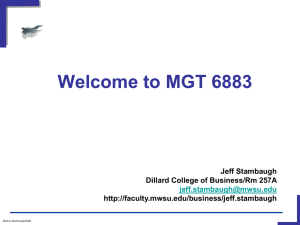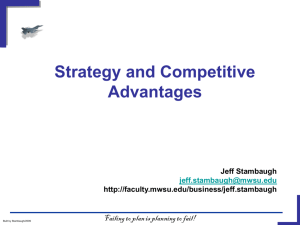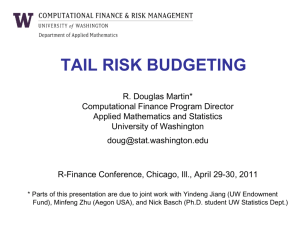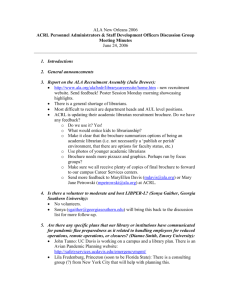bus strategy
advertisement
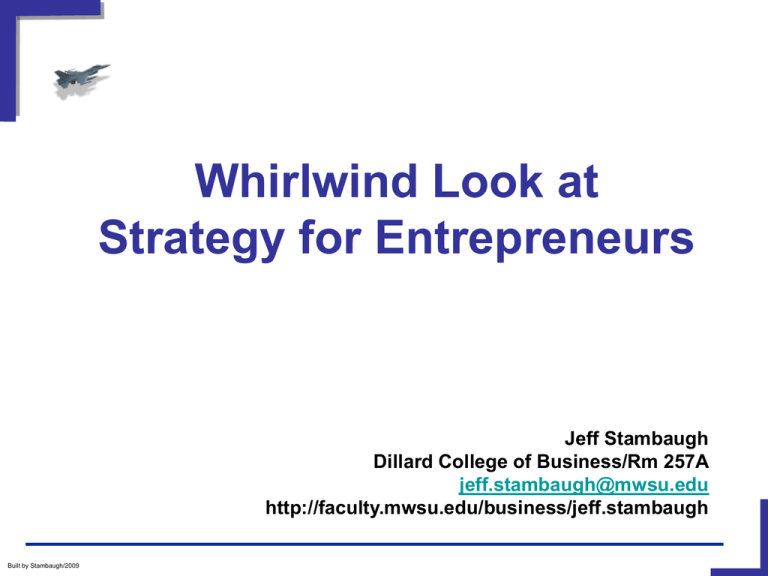
Whirlwind Look at Strategy for Entrepreneurs Jeff Stambaugh Dillard College of Business/Rm 257A jeff.stambaugh@mwsu.edu http://faculty.mwsu.edu/business/jeff.stambaugh Built by Stambaugh/2009 Whirlwind Look at ENT Strategy ■ ■ ■ Feasibility analysis: Is this truly a potential business? Industry analysis: Is this truly an attractive industry to enter? Business Strategy / Model: How can I generate value for everyone? Built by Stambaugh/2009 More on Feasibility ■ ■ ■ Is there a market for the product (value for customers)? Are there margins for the firm? Is there sufficient volume over time ■ ■ ■ Size of Market Repetition of purchases Fad? If it’s feasible, it appears I have a business (valid ENT opportunity) Built by Stambaugh/2009 Ways to Test Feasibility ■ ■ ■ Prototypes / Focus groups Web (Second Life) Small trials (local markets, eBay, etc) Built by Stambaugh/2009 Industry Analysis ■ ■ ■ ■ How do firms generate value and compete Is this an attractive industry to enter Industry: firms producing products that are close substitutes for each other Standard Industry Classification (SIC) and North American Industry Classification System (NAICS) http://www.census.gov/epcd/www/naics.html Built by Stambaugh/2009 Porter’s Five Forces Built by Stambaugh/2009 Threat of New Entrants Threat of new entrants greatest when Built by Stambaugh/2009 Low economies of scale (or no cost disadvantages independent of scale) Low capital requirements (or easy access to funds) Low switching costs Little Differentiation Easy access to distribution channels Government policy does not inhibit new entries Bargaining Power of Buyer Greater when: Buyer is a major customer for supplier Low switching costs Undifferentiated products Able to backward integrate Buyer earns low profits Buyer doesn’t rely on product for key attributes (e.g. quality) Built by Stambaugh/2009 Bargaining Power of Suppliers Greater when: Few large suppliers and buying firms’ industry Built by Stambaugh/2009 not concentrated. No substitute products Supplier not reliant on buyer’s business Suppliers’ goods are essential to buyer High switching costs for buyers or differentiated product Suppliers could forward integrate into buyer’s business Substitute Products Another way for the customer to “scratch the itch” Limits industry profitability Also suggests possible threats: The car vs Southwest Airlines Email / fax vs FedExing documents overnight Cable TV versus videogames? Built by Stambaugh/2009 Rivalry Among Competitors Rivalry among existing firms increases when: Little degree of differentiation Low switching costs Numerous / equally balanced competitors Slow industry growth High strategic stakes High fixed costs or high storage costs High exit barriers Built by Stambaugh/2009 Only the Paranoid Survive … Andy Grove Powerful Competitors versus New Entrants ■ ■ ■ ■ ■ Are they likely to be aware of the entry? Do you threaten them in a way they are likely to react? Do they have the capability to respond? What’s their track record? What do Google, JetBlue, and Netflix all have in common? Built by Stambaugh/2009 Industry Life Cycle ■ Fragmented versus Concentrated Industries Built by Stambaugh/2009 Online Tools for Industry Analysis ■ ■ ■ ■ From our library http://library.mwsu.edu/research.asp From WSJ http://online.wsj.com/home/us www.bizstats.com Hoovers: http://www.hoovers.com/free/ind/fr/list.xhtml Built by Stambaugh/2009 Fundamental StrategyQuestions ■ How are we going to create value for our customer (or less noble—how are we going to motivate them to buy our product / service?): ■ ■ ■ ■ ■ By being the cheapest? By offering the most desirable features / services? By serving a niche market? By melding low cost and some unique features? And how do my competitive advantages play into this? http://images.businessweek.com/ss/08/09/0908_2007_finalists/19.htm Business-level strategy: decisions that describes how firm will compete in its chosen industry / market segment Built by Stambaugh/2009 The purpose of business is to create and keep a customer … Drucker Generic Strategies ■ ■ ■ Built by Stambaugh/2009 Cost Leadership Differentiation Focus The purpose of business is to create and keep a customer … Drucker Overall Cost Leadership ■ Comparable (decent) product that you can produce cheaper than competitors by …. ■ ■ ■ ■ ■ ■ Scale-efficient operations Cost reductions from experience Overall cost control Avoid marginal accounts Squeeze value chain Typical ENT Options • Local cost advantage • Specialization cost adv • Underused resource • Better management Lower costs + same price to consumer = higher profits (or lower price increased volume = higher profits) Built by Stambaugh/2009 The purpose of business is to create and keep a customer … Drucker Differentiation ■ Bases for differentiation ■ Prestige ■ Product features ■ Service Competitive advantage comes when people pay more for it than it costs you to provide it Built by Stambaugh/2009 The purpose of business is to create and keep a customer … Drucker Focus Strategies ■ ■ ■ ■ Geographic Demographic Income scale (both high and low) Unique product requirements http://images.businessweek.com/ss/08/09/0908_2007_finalists/7.htm Built by Stambaugh/2009 The purpose of business is to create and keep a customer … Drucker Supra-Strategies of Differentiation ■ ■ ■ ■ ■ ■ ■ Craftsmanship Customization Super-support Serving underserved / interstices Elite Single-mindedness Comprehensiveness Built by Stambaugh/2009 The purpose of business is to create and keep a customer … Drucker Combination Strategy (Integrated Cost and Differentiation) ■ ■ Efficiently provide unique value (hit the midspectrum) Tougher to imitate but also harder to implement Built by Stambaugh/2009 The purpose of business is to create and keep a customer … Drucker Innovation ■ ■ Incremental vs pure Usually with a differentiation or combo strategy Built by Stambaugh/2009 What is a Competitive Advantage ■ ■ Superior financial returns (staying ahead of competitors)! Some ENTs may settle for much less How do I generate a competitive advantage? Built by Stambaugh/2009 Value Chain ■ ■ ■ Value = Total revenue (price x quantity) Two views: value generator, waste minimizer Internal / External Fit Built by Stambaugh/2009 Do what you can, with what you have, where you are … T. Roosevelt Resources ■ Tangible (things you can see / quantify): ■ ■ ■ ■ ■ Intangible (things you can’t see / quantify) ■ ■ ■ ■ Financial (balance sheet, ability to borrow) Physical (plant and equipment) Technological (patents, trade secrets) Organizational (planning processes and control systems) Human (knowledge, skill, trust, leadership) Innovation Reputation Organizational Capabilities (competences / capacity to combine) Built by Stambaugh/2009 Do what you can, with what you have, where you are … T. Roosevelt Core Competencies ■ ■ Capabilities firm emphasizes / performs especially well while pursuing its vision Core competencies lead to competitive advantage ■ Do something better ■ Do something others can’t Built by Stambaugh/2009 Do what you can, with what you have, where you are … T. Roosevelt VRIO ■ ■ ■ ■ Valuable (can it increase sales or decrease costs?) Rare (how many others have it?) Imitability (how easy can it be copied?) Organization (Can we use the resource?) Built by Stambaugh/2009 Resources/Capabilities that Lead to Competitive Advantage (CA) ■ Difficult to Imitate/Substitute: ■ Physical uniqueness ■ Path dependent (history matters) ■ Causal ambiguity ■ Socially complex Built by Stambaugh/2009 Do what you can, with what you have, where you are … T. Roosevelt Class Takeaways ■ ■ ■ ■ Is it feasible? Is it an attractive industry? Business model / strategy How will I generate a competitive advantage? Built by Stambaugh/2009
